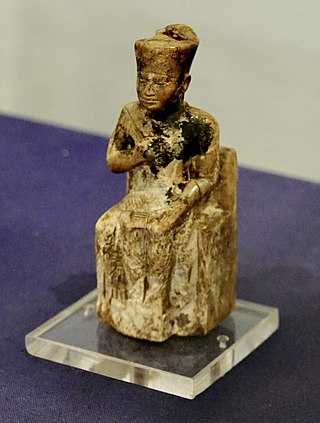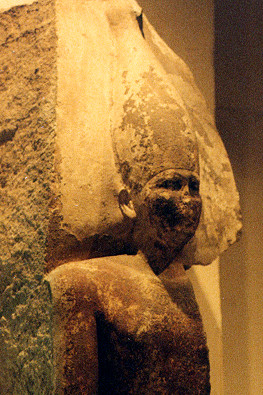The 27th century BC was a century that lasted from the year 2700 BC to 2601 BC.

Usermaatre Meryamun Ramesses III was the second Pharaoh of the Twentieth Dynasty in Ancient Egypt. Some scholars date his reign from 26 March 1186 to 15 April 1155 BC, and he is considered the last pharaoh of the New Kingdom to have wielded substantial power.

The greylag goose or graylag goose is a species of large goose in the waterfowl family Anatidae and the type species of the genus Anser. It has mottled and barred grey and white plumage and an orange beak and pink legs. A large bird, it measures between 74 and 91 centimetres in length, with an average weight of 3.3 kilograms. Its distribution is widespread, with birds from the north of its range in Europe and Asia often migrating southwards to spend the winter in warmer places, although many populations are resident, even in the north. It is the ancestor of most breeds of domestic goose, having been domesticated at least as early as 1360 BCE. The genus name and specific epithet are from anser, the Latin for "goose".

Khufu or Cheops was an ancient Egyptian monarch who was the second pharaoh of the Fourth Dynasty, in the first half of the Old Kingdom period. Khufu succeeded his father Sneferu as king. He is generally accepted as having commissioned the Great Pyramid of Giza, one of the Seven Wonders of the Ancient World, but many other aspects of his reign are poorly documented.

Zahi Abass Hawass is an Egyptian archaeologist, Egyptologist, and former Minister of Tourism and Antiquities, serving twice. He has worked at archaeological sites in the Nile Delta, the Western Desert and the Upper Nile Valley.

Huni was an ancient Egyptian king, the last pharaoh of the Third Dynasty of Egypt during the Old Kingdom period. Based on the Turin king list, he is commonly credited with a reign of 24 years, ending c. 2613 BC.

The Giza pyramid complex in Egypt is home to the Great Pyramid, the Pyramid of Khafre, and the Pyramid of Menkaure, along with their associated pyramid complexes and the Great Sphinx. All were built during the Fourth Dynasty of the Old Kingdom of ancient Egypt, between c. 2600 – c. 2500 BC. The site also includes several temples, cemeteries, and the remains of a workers' village.

Hemiunu was an ancient Egyptian prince who is believed to have been the architect of the Great Pyramid of Giza. As vizier, succeeding his father, Nefermaat, and his uncle, Kanefer, Hemiunu was one of the most important members of the court and responsible for all the royal works. His tomb lies close to west side Khufu's pyramid.

Meidum, Maydum or Maidum is an archaeological site in Lower Egypt. It contains a large pyramid and several mudbrick mastabas. The pyramid was Egypt's first straight-sided one, but it partially collapsed in ancient times. The area is located around 72 kilometres (45 mi) south of modern Cairo.

A domestic goose is a goose that humans have domesticated and kept for their meat, eggs, or down feathers, or as companion animals. Domestic geese have been derived through selective breeding from the wild greylag goose and swan goose.

Sneferu or Soris was an ancient Egyptian monarch and the first pharaoh of the Fourth Dynasty of Egypt, during the earlier half of the Old Kingdom period. He introduced major innovations in the design and construction of pyramids, and at least three of his pyramids survive to this day.

Itet also known as Atet, was a royal woman who lived in ancient Egypt. She was the wife of Nefermaat, who was the eldest son of king Sneferu as well as a vizier and a religious leader in the royal court who officiated in the worship of Bastet. She was the mother of three daughters and many sons. Her son, Hemiunu, succeeded her husband as vizier. She and her husband are buried in mastaba 16 at Meidum. Their tomb is famous for paintings of geese, and of other animals, as well as depictions of daily family life.

Rahotep,, was a prince, the son of pharaoh Snofru and his first wife Hetepheres I, in ancient Egypt during the 4th Dynasty, reign of his father Snofru possibly his brother Khufu too..

Ranefer was a prince of ancient Egypt during the 4th Dynasty.
Djedi was an Egyptian prince who lived during Fourth Dynasty of Egypt. He was a son of Prince Rahotep and Nofret, grandson of pharaoh Sneferu and nephew of pharaoh Khufu. He had two brothers and three sisters. He is depicted in the tomb chapels of his parents and bears there the title "King's Acquaintance".

Nefermaat II was a member of the Egyptian royal family during the 4th Dynasty and vizier of Khafre.

Nofret was a noblewoman and princess who lived in Ancient Egypt during the 4th dynasty of Egypt c. 2613 to 2494 BC. Nefert means "beautiful". Nofret is alternatively known as Nefert or Neferet.

Pyramid G1-d is a satellite pyramid within the Khufu pyramid complex on the Giza plateau.

Luigi Vassalli was an Italian Egyptologist and patriot.






















